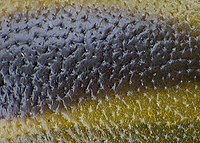Striped rape leaf beetle
| Striped rape leaf beetle | ||||||||||||
|---|---|---|---|---|---|---|---|---|---|---|---|---|

Striped rape leaf beetle |
||||||||||||
| Systematics | ||||||||||||
|
||||||||||||
| Scientific name | ||||||||||||
| Entomoscelis adonidis | ||||||||||||
| ( Pallas , 1771) |

|
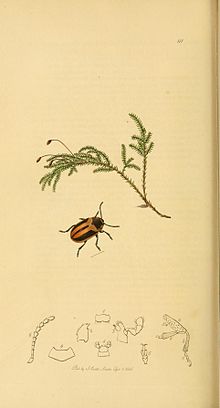 1 upper lip 2 upper 3 lower jaw 4 lower lip 5 leg with straight and angled splint |
| Fig. 1 Front rail , copy on the right colored red: groove on the back of the rail |
|
| Fig. 2 green: Prosternal process | Fig. 3 Engraving by Curtis 1840 |

|
|
| Fig. 4 pronotum, posterior angle | Fig. 5 Dotting of the wing cover |

|
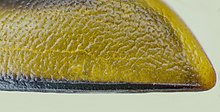
|
| Fig. 7 Rear part of the wing cover seam with seam strips, tapering to the left (corresponds to the front) |
|
| Fig. 6 Anterior tarsus | |
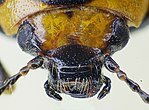 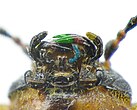 
|
|
| Fig. 8 Head from above, below, side; partially colored; green: tip of the upper jaw, yellow: terminal jaw palpation, blue: lip palpation |
|
The striped rapeseed leaf beetle ( Entomoscelis adonidis ) is a beetle from the leaf beetle family . The genus Entomoscelis is represented in Europe with four species , which are divided into two subgenera. Worldwide the genus comprises seven species in five subgenera. The species is listed in the Red Lists of Germany under category 2 (endangered).
Notes on the name
The species was first described by Pallas in 1771 under the name Chrysomela adonidis as the 29th species of the genus Chrysomela . Pallas closes the seven-line description in Latin with the words Victitat Adonide verna; Maio copiose lecta ad Volgam (lives on the spring Adonis , often collected on the Volga in May ). This explains the species name adónidis ( living on the Adonis Adonis ).
The genus Entomoscelis was proposed by Chevrolat in 1837 when editing the catalog for the Dejean collection . The catalog appears in 1837 and Déjéan takes over the generic name proposed by Chevrolat and notes in the foreword of the catalog: Regarding the Chrysomelinae ... with which Monsieur Chevrolat in particular was concerned ... I have adopted all the genera ... created by him ( fr. Quant aux chrysomélines ... M. Chevrolat s'en étant particulièrement occupé, ... j'ai adopté tous les genres qu'il a crées). The genre is not yet described in the catalog itself, but with reference to the catalog and its foreword, the description by Chevrolat appears in Volume 5 of the Dictionnaire universel d'Histoire naturelle (Encyclopedia of Natural History), published in 1749 . Chevrolat also explains the generic name by specifying the etymology of altgr. εντομή "entomé" for "incision" and σκέλος "skélos" for "thigh". The name refers to an incision at the end of the splint to accommodate the first tarsal link .
The vernacular name "striped rape leaf beetle" is explained by the black stripes and the fact that the leaf beetle also occurs on rape.
Description of the beetle
The seven to ten millimeter long beetle has the typical oval shape of a leaf beetle, compared to Entomoscelis sacra , the second Central European species of the genus, it is more elongated oval. The antennae, underside and legs are black, the head, breast shield and winged wing are fiery red with a drawing by black spots and stripes, which vary greatly in size, but are fairly constant in their position. In dead animals the red color fades to brick-red to yellow-brown.
The slightly arched head (Fig. 8) is slightly inclined and drawn into the pronotum up to the eyes. It is wider than it is long and narrowed in front of the eyes, so that the front part appears broadly pulled forward like a snout. Between the antennae roots there is a slightly curved, recessed transverse line (left in Fig. 8), which clearly separates the dark head shield from the light forehead. The head shield is set off from the upper lip in front with a broad parallel stripe. At the upper edge of each eye there is an indentation that is continued with a slight bevel in the front (Fig. 8 left). The head is clearly dotted only on the head shield, especially on the front edge. The front part of the head with the cheeks and an occasional missing vertex are black. The front of the upper lip has long bristle hairs arranged in two rows (Fig. 8 left and right picture and Fig. 3/1). The upper jaws are split into two pointed, sharp teeth at the tip (in Fig. 8 center green tinted and Fig. 3/2). The inner edge of the right upper jaw has another pointed tooth halfway up, the inner side of the left upper jaw is toothless and ribbed. The end link of the four-part jaw palpation (in the middle of Fig. 8 tinted yellow and Fig. 3/3) is conical. The slightly curved eyes are much wider vertically than horizontally and narrower below than above (Fig. 8 right). The eleven-part antennae are well separated from one another and clearly deflected in front of the anterior edge of the eye. They are moderately slim and about half the length of the body. Towards the end the antennae is hardly thickened; the six last links are somewhat wider than the previous ones. The second to fifth links are slightly compressed, the third twice as long as the second (Fig. 8 right). The first two antennae segments are often brownish at the ends.
The pronotum is almost twice as wide as it is long and evenly slightly arched. In front the pronotum is only slightly curved and has dense and fine ciliate (Fig. 8 left and right). The sides are finely edged. The base is slightly double-indented and unedged (Fig. 4). The rear corners are rectangular when viewed from above. The dotting is coarse and not very dense. A broad median stripe of the pronotum that widens towards the base is black. To the side of each is a small black spot in the front half of the pronotum.
The black label has roughly the shape of an ellipse halved at the small diameter .
The elytra are elongated oval, at the base about the same width as the pronotum, overall only slightly wider than this. They are about one and a half times as long as they are together wide. They completely cover the abdomen and are broadly rounded at the top. The underlayment edges (epipleurs) narrow towards the back and become indistinct at the tip. In the rear half of the wing cover, a line runs a short distance from the wing cover seam and parallel to it, which is deeply cut in the rear area, but flattens out and tapers towards the front (Fig. 7, tapering to the left). Longitudinal dimples are missing in the apex angle of the wing covers. The lateral edge of the elytra is also not ciliated behind. The puncture of the elytra is coarser than that of the pronotum, almost wrinkled (Fig. 5). A narrow black hem runs over the seam. It widens a little towards the front and ends in front of the label at a distance that corresponds approximately to the length of the label. To the side of each wing cover runs a wide black ribbon.
The front hips are clearly separated from each other by the front chest (tinted green in Fig. 2). The rear chest is longer in the middle than the front chest. The legs are strongly built. The rails of all legs are notched at the top so that the tarsi can be folded up. This notch, which is quite common in leaf beetles, continues in a groove on the back of the splint, which narrows and extends far towards the knee (tinted red in the copy on the right in Fig. 1). In addition to the deflection of the tarsus, the outer edge of the groove is only slightly raised to a blunt tooth, and not drawn out into a pointed tooth on the middle pair of legs. Overall, the rail is only slightly widened at the end and remains narrower than the leg. There are also no thorns at the end of the tarsen. The third tarsal phalanx, in which the claw phalanx is located, is only strongly margined on the upper side, not consistently bilobed (Fig. 6). The claws are not sawed or toothed (Fig. 6).
biology
The warmth-loving species lives in open areas on dry grassland or in fields. The beetles and larvae feed on plants. The classic host plant is the Adonis rose, but the species is also found on various types of beets and cruciferous vegetables . It is reported as a pest on canola, cabbage, and mustard. In areas where potatoes are predominantly grown, the presence of the beetle has a positive effect by killing weeds from the cruciferous family. The larvae feed mainly on young leaves, the beetles on older leaves, flowers and buds.
In Central Europe, larval feeding takes place in April, pupae are found in May and the newly hatched beetles appear in early June. The eggs are laid in autumn and overwintering takes place in the egg stage.
The disappearance of the beetle during the summer months was first scientifically investigated by the Hungarian Sajo. In response to a written notification to the Entomological Station of the Kingdom of Hungary in the 1880s that the beetle had been found in the ground in summer, Sajo observed specimens of the species in an insectarium and was able to determine that the animals hid in the ground in May and not until October reappeared. He then found the phenomenon of summer dormancy in other leaf beetles and also tried to find reasons for it. He suspected a self-cleaning process of metabolic toxins in the summer diapause .
In Romania, the biology of the species was followed for several years. After that, the larvae of the first instar rarely hatch later than February or March. The larvae eat for between 24 and 54 days, in the laboratory at 20 ° C for nineteen days. At artificially generated temperatures between 25 ° and 29 ° on the one hand and 6 ° to 8 ° on the other hand, the mortality rate was very high. After that, the larvae go into the ground to pupate. At a depth of three to four centimeters, they compact the earth into a doll's chamber. The pre-pupal and pupal stages together last around 30 to 40 days, in the laboratory at 20 ° it takes around 12 days. The pupal stage alone was shortened to five days at 29 °, and lengthened to 57 days at 5 ° - 7 °. The finished beetles appear in the Danube plain at the end of April at the beginning of May, in northern Bulgaria a week later. In search of fodder plants, they cover distances of up to ten kilometers. After a period of fifteen to thirty days of ripening, they bury themselves for a good three months at a depth of fifteen to just under a foot. They appear for mating again in September. A few days later, the females begin to lay eggs. The eggs are placed in or on the floor in packets of about fifteen eggs. In the laboratory, the duration of the filing activity varied between five and 45 days. A maximum of over two thousand eggs were laid. In nature, the main laying time is from the end of September to the beginning of November, but eggs are also occasionally laid in December and January. Similar numbers are reported from China.
The fungus Beauveria bassiana , which attacks beetles that are dormant in summer, are named as natural enemies . The bug Nabis ferus attacks larvae, the beetle Lebia cyanocephala prey on eggs, larvae and pupae. The caterpillar fly Meigenia mutabilis parasitizes the larva.
distribution
The species is distributed as far as China in the Palearctic. In more northerly Europe (British Isles, the Benelux countries, Norway, Sweden and Finland, some Russian provinces) the species is absent. In addition, no finds are known from most of the islands. In the rest of Europe, too, the known finds do not cover all countries. Of the German-speaking countries, the occurrence in Switzerland is doubtful. Similar beetles found in America were previously mistaken for Entomoscelis adonidis . Today, however, they are listed as Entomoscelis americana .
literature
- Heinz joy, Karl Wilhelm Harde, Gustav Adolf Lohse (ed.): The beetles of Central Europe . tape 9 . Cerambycidae Chrysomelidae . Spektrum Akademischer Verlag, Munich 1999, ISBN 3-8274-0683-8 , pp. 192 (first edition: Goecke & Evers, Krefeld 1966).
- Klaus Koch : The Beetles of Central Europe . Ed .: Heinz Freude . tape 3 : ecology . Goecke & Evers, Krefeld 1992, ISBN 3-87263-042-3 , pp. 92 .
- Gustav Jäger (Ed.): CG üdeCalwer’s Käferbuch. K. Thienemanns, Stuttgart 1876, 3rd edition p. 572
- Edmund Reitter : Fauna Germanica, the beetles of the German Empire. Volume 4, KGLutz 'Verlag, Stuttgart 1912, p. 125.
- Luc Auber: Coléoptères de France. Fascicule III Edition N.Boubée & Cie, Paris 1955, p. 34.
Individual evidence
- ↑ a b Entomoscelis adonidis in Fauna Europaea. Retrieved January 29, 2014
- ↑ Entomoscelis in Fauna Europaea. Retrieved January 29, 2014
- ^ Taxon profile of Entomoscelis Chevrolat , 1843
- ↑ Red Lists at Science4you, as of 1998
- ^ PS Pallas: Journey through different provinces of the Russian Empire 1st part St. Petersburg 1771 p. 463 First description in GDZ p. 503: 463
- ↑ Sigmund Schenkling: Explanation of the scientific beetle names (species)
- ↑ Yves Bousquet, Patrice Bouchard: The genera in the second catalog (1833-1836) of Dejeans's Coleoptera collection Zookeys 2013: (282): 1 - 219, PMC 3677338 (free full text).
- ^ Dejean : Catalog des coléoptères de la collection de M. Le Conte Déjéan 3rd edition Paris 1837 Genus Entomoscelis p. 426, Explanation S.xiij Genus Entomoscelis in the Google book search
- ^ Dictionnaire universel d'Histoire naturelle 5th volume Paris 1749 p. 335 in BHL encyclopedia entry Entomoscelis
- ↑ Sigmund Schenkling: Explanation of the scientific beetle names (genus) .
- ↑ a b c W.F. Erichson (Hrsg.): Natural history of the insects of Germany - Coleoptera 6th volume, Berlin 1893 p. 310 ff at BHL p . 310 ff
- ↑ OLNesterova: Comparitive Morphological Characteristics of Palaearctic Leaf Beetles of the Subtribe Entomoscelina (Coleoptera: Chrysomelidae): I. Mouthparts Entomological Review Vol. 87 No. 6 pp 822-829, doi : 10.1134 / S0013873807070044 .
- ^ A b Ludwig Redtenbacher: Fauna Austria approx. Die Käfer 2nd increased edition Vienna 1885 p. 918 at BHL p. 918
- ↑ Károly Vig: On whose shoulders we stand - the pioneering entomological discoveries of Károly Sajó Zookeys 2011 (157) 159-179, doi : 10.3897 / zookeys.157.2044 , PMC 3253647 (free full text).
- ↑ a b F.C.Manolache: "Investigations on the Morphology, Biology and Control of E. Adonidis in Romania" Bucharest 1940 at cabdirect
- ↑ Si-Qin Ge, Mauro Daccordi, Shu-Yong Wang, Xing-Ke Yang: "Study of the Genus Entomoscelis Chevrolat (Coleoptera: Chrysomelidae: Chrysomelinae) from China" Proceedings of the Entomological Society of Washington 111 (2): 410- 425. 2009 doi : 10.4289 / 0013-8797-111.2.410
- ↑ WJ Brown: "The American species of Entomoscelis and Hippuriphila (Coleoptera: Chrysomelidae)" The Canadian Entomologist Vol.74 Edition 09 Sept. 1942 pp 172-176, doi : 10.4039 / Ent74172-9 .

